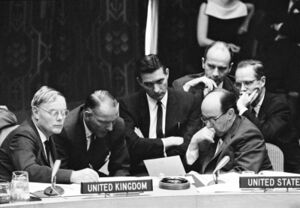Sivert Nielsen
(diplomat, financier) | |||||||||||||||||||||
|---|---|---|---|---|---|---|---|---|---|---|---|---|---|---|---|---|---|---|---|---|---|
 Discussing a document at the UN in 1964 (l. to r.) are: Sir Patrick Dean (United Kingdom), Mr. Sivert A. Nielsen (Norway), and Mr. Adlai E. Stevenson (United States). Behind them (l. to r.): Mr. Francis T. Underhill (United States), Mr. Donald R. Toussaint (United States), and Mr. Charles Woodruff Yost (United States). | |||||||||||||||||||||
| Born | 24 November 1916 Copenhagen, Denmark | ||||||||||||||||||||
| Died | 17 March 2004 (Age 87) Oslo, Norway | ||||||||||||||||||||
| Nationality | Norwegian | ||||||||||||||||||||
| Alma mater | Oslo University | ||||||||||||||||||||
A central player in Norwegian military and foreign policy in the decades after the WW2. Later Ambassador to UN. Attended the 1977 Bilderberg at end of active career.
| |||||||||||||||||||||
Sivert A. Nielsen was a central player in Norwegian military and foreign policy in the decades after the Second World War, as State Secretary in the Ministry of Defence 1955–58 and Norwegian UN Ambassador 1958–66. He ended his professional career as a bank manager in Bergens Privatbank 1966–76,[1] and attended the 1977 Bilderberg meeting.
Contents
Background
Nielsen was born while his father, Professor Konrad Nielsen, worked for the Swedish-Norwegian reindeer herding commission in Copenhagen, but the family moved back to Norway before Sivert was one year old. He studied law and became a cand.jur in spring 1940, the same year of the German invasion.[1]
World War 2
In the autumn of 1940, Nielsen was employed by Norges Bank. He was later transferred to Norway's Clearing Institute, where he worked with German payments. He passed on information about German imports and exports to the resistance, which cost him four years in German captivity, mainly in Sachsenhausen concentration camp outside Berlin.[1]
Ministry of Defence and NATO
After returning to Norway in the spring of 1945, Nielsen worked for a short time with treason investigations a police deputy at the Oslo Police, before he got a position in the Norwegian Employers' Union. The following year he was employed in the secretariat of the United Nations (UN). While working at the UN headquarters in New York, he was recruited into diplomacy. In 1948, he was brought to the Norwegian embassy in Washington to strengthen the staff in connection with the creation of the Atlantic Pact, and he was part of the group that drafted the NATO treaty.
Nielsen's knowledge of Western military cooperation led to his appointment as bureau chief in the Ministry of Defence in 1950. In 1951–52 he was director of NATO's international staff in London. He then returned to the Ministry of Defence, as head of expedition 1952–55 and state secretary 1955–58. He played a prominent role in shaping Norwegian security policy in the period, including when it came to Norwegian nuclear weapons policy. Nielsen knew long time Prime Minister Einar Gerhardsen from Sachsenhausen, but was never a member of the Labour Party and had no party political ambitions, despite extensive speculation about ministerial posts and a place in the government.[1]
Later career
In 1958, Nielsen was appointed Norway's ambassador to the UN in New York, a post he held for 8 years. During this period, Norway was a member of the Security Council for two years (1963–64), while i.a. The Cyprus crisis and the Congo conflict were among the most important topics on the agenda.
After finishing at the UN, Nielsen returned home to Norway in 1966, where he became bank manager in the foreign department of Bergens Privatbank; 1969–76 he was manager of the bank's Oslo office and a member of its board. Nielsen was chairman of the board of NORAD 1969–74, but eventually withdrew from public activities. In his last working years, he worked as a consultant and adviser in shipping and finance. He was appointed a knight of the 1st class of the Order of St. Olav in 1964.[1]
Event Participated in
| Event | Start | End | Location(s) | Description |
|---|---|---|---|---|
| Bilderberg/1977 | 22 April 1977 | 24 April 1977 | Imperial Hotel Torquay United Kingdom | The 25th Bilderberg, held in Torquay, England. |